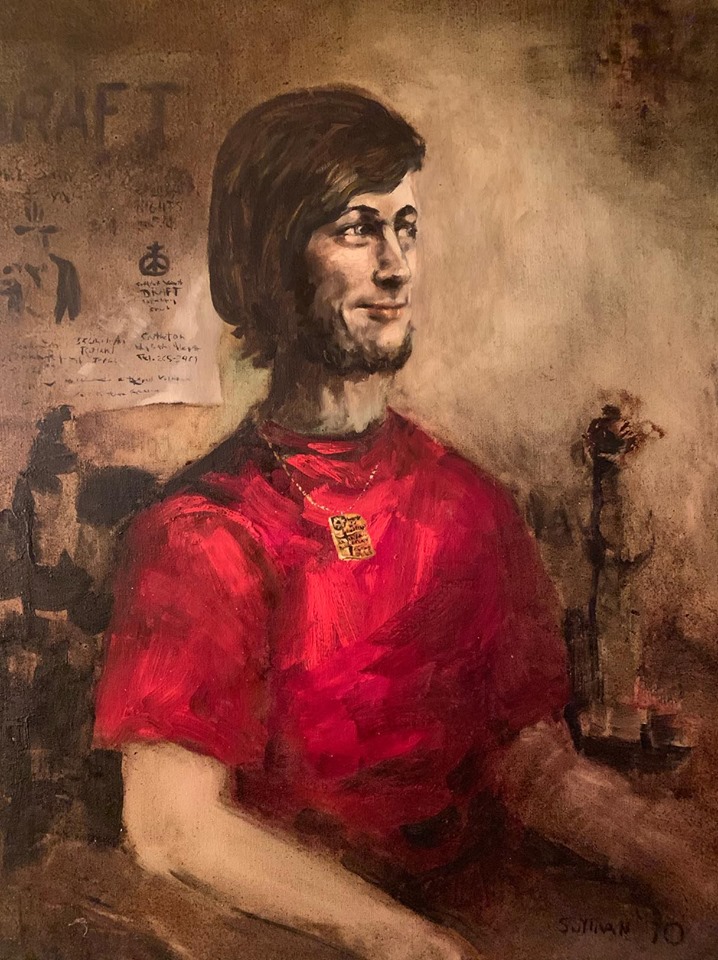By Jaime Manrique
Bill Sullivan and I met in Julius’, a bar in NYC’s Greenwich Village, on the Fourth of July, 1977. I was sitting at the bar, watering my scotch to make it last, and pretending to read George Santayana’s Last Puritan, which I thought sounded like a suitably impressive title to attract an intelligent boyfriend. It worked! When our eyes met, Bill said, “I’ve never seen anyone reading a book in a bar.”
That night, Bill and I began an epic relationship that, despite many ups and downs, lasted 33 years. I was 27, and living the life of the destitute Latin American writer who was a newcomer to the city. Bill was 34 years old, several years out of graduate school, had already shown his work in downtown galleries, and was preparing what would be his first “uptown” show at G. W. Einstein (a gallery that no longer exists). At that time Bill was painting almost exclusively the Hudson River, and the incipient New Jersey skyline, from the crumbling wooden piers in the West Village, and also from the ruins of the West Side Highway (which decades later became the High Line). Before he became a landscape and cityscape painter, a maestro of light, Bill had painted a series of gay and lesbian people with whom he had formed “families” in his loft on 27th Street near 7th Avenue. Very few of those paintings survive.
About two months ago, the Carrie Haddad Gallery in Hudson, New York received a query from Ireland asking whether they could identify a portrait as a Bill Sullivan. I requested a photograph from the gallery and immediately recognized Bill’s unmistakable signature. I also recognized the candlestick– just to the left of the sitter– which Bill owned until his death. The portrait is dated 1970, the year Bill had his first solo show at the Bowery Gallery. Few people know that while still in his teens, Bill had fallen in love with the paintings of El Greco and Velázquez. When I showed the photo of the portrait to Isaías Fanlo, without missing a beat he said, “It reminds me of El Greco.”
The owner of the painting in Ireland was looking to sell the painting, and I knew I must buy it. When it arrived at my apartment, I was astonished that it was much larger than I had thought. It was also in immaculate condition, as if it had been painted in 2019, not almost 50 years ago.
I asked Erin Clermont, who was a close friend of Bill back then if she could identify the sitter, and she said,“He was probably one of the handsome young men Bill was always in love with.” It’s clear to me that only a painter infatuated with his subject could have caught the mischevious but intimate expression in the eyes of the sitter; and only someone who had lusted after this handsome young man could have painted his lower lip red and so fleshy and luscious. There’s something very touching about the young man whose eyes shine with the glow that we acquire when we are in love.
The painting now hangs in my small living room/study in the West Village. It completely overwhelms all the other paintings and objects in the room. Since its arrival, I’ve written in my head several stories about the identity of this young man. Who was he? Is he still alive? How long did his affair/relationship/moment of love with Bill last? Days? Weeks? Months? How did the painting end up in Ireland? And how, almost five decades later, it came to me without a scratch—without a wrinkle?
I find it impossible not to think about Oscar Wilde’s immortal novel The Portrait of Dorian Grey, except that in this case it is us (Bill, me, and perhaps the sitter, if he’s still alive) who have aged. As has our world, so different from the late 60s, and early 70s, when we were young, dreaming utopias, bent upon changing the old useless structures and prejudices, and creating new ways of interacting with each other. Yet the sitter in Bill’s portrait conserves a kind of innocence, a sparkle, an uncorrupted air, caught forever in the splendor of his youth.
Happy 42nd anniversary, my dear Bill. You always said that the evening when we walked out of Julius’ there were fireworks going on and that they continued the years we shared our lives. You’re gone from this world, but your art keeps speaking your truth.
JAIME MANRIQUE is a Colombian-born novelist, poet, essayist, and translator who writes both in English and Spanish, and whose work has been translated into _fifteen languages. Among his publications in English are the novels Colombian Gold, Latin Moon in Manhattan, Twilight at the Equator, Our Lives Are the Rivers, and Cervantes Street; he has also published the memoir Eminent Maricones: Arenas, Lorca, Puig, and Me. His honors include Colombia’s National Poetry Award, a 2007 International Latino Book Award (Best Novel, Historical Fiction), and a Guggenheim Fellowship. He is a distinguished lecturer in the Department of Modern and Classical Languages and Literatures at the City College of New York. Like This Afternoon Forever is his latest novel.










